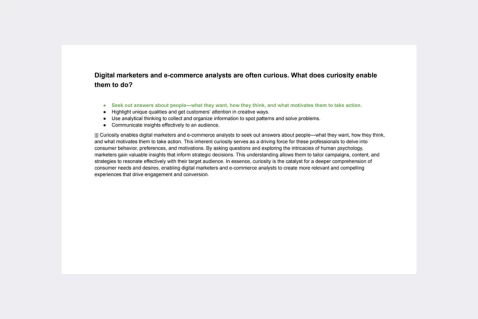A digital marketer aims to increase a website’s visibility by optimizing the images for speed. What should they remember when uploading these images to the website?
When uploading an image, resize it to the correct size without losing its quality**
Search engines automatically generate a title and snippet to describe an image
Position an image prominently on the page away from relevant text
Keyword stuffing will help search engines understand the subject of an image
Certification program: 👉 Google Digital Marketing & E-commerce Professional Certificate (Coursera)
Explanation: When aiming to increase a website’s visibility by optimizing images for speed, a digital marketer should remember to “resize the image to the correct size without losing its quality” when uploading. This best practice involves finding a balance between maintaining visual integrity and ensuring the image file size is minimized for faster loading times. By resizing images appropriately, marketers can enhance the website’s performance, decrease page load times, and positively impact user experience. This practice aligns with SEO strategies, contributing to improved search engine rankings, especially considering that page speed is a crucial factor in search algorithms.
Passing exams is not a workout. Multiple attempts won’t make you stronger.



- All possible certificate program questions
- Real certification exam questions
- Detailed answer explanations.
- Over 1700 questions, 7 courses, 30 quizzes
- Free lifetime updates.
Optimizing Website Images for Speed: Best Practices for Digital Marketers
In today’s fast-paced digital landscape, website speed plays a crucial role in user experience and search engine rankings. As a digital marketer, optimizing images for speed is essential to enhance website performance and boost visibility. In this blog post, we’ll explore practical insights and best practices for uploading images to a website while prioritizing speed optimization.
Choose the Right File Format
When uploading images to a website, choosing the appropriate file format is key to optimizing speed and preserving image quality. For photographs and images with complex graphics, consider using JPEG format, which offers a good balance between image quality and file size. For images with transparency or crisp edges, such as logos or icons, opt for PNG format. Avoid using uncompressed formats like BMP or TIFF, as they result in larger file sizes and slower loading times.
Compress Images Without Compromising Quality
Before uploading images to your website, compress them to reduce file size without sacrificing visual quality. Utilize image compression tools or plugins to automatically optimize images for the web. Aim to strike a balance between file size reduction and image clarity to ensure fast loading times without noticeable loss of detail. By compressing images, you can significantly improve website speed and enhance user experience, especially on mobile devices with limited bandwidth.
Resize Images for Web Display
Large, high-resolution images can significantly slow down website loading times, particularly on devices with slower internet connections. Resize images to the appropriate dimensions for web display, taking into account the layout and design of your website. Avoid uploading oversized images and rely on responsive design techniques to ensure images adapt seamlessly to different screen sizes and resolutions. By resizing images for web display, you can optimize website speed and deliver a smooth browsing experience across all devices.
Leverage Image Lazy Loading
Implement image lazy loading techniques to prioritize the loading of visible content first, improving perceived website speed and user engagement. With lazy loading, images are only loaded when they enter the user’s viewport, reducing initial page load times and conserving bandwidth. Explore lazy loading plugins or incorporate native lazy loading attributes in HTML to streamline image delivery and enhance overall website performance.
Test and Monitor Performance
After uploading and optimizing images on your website, regularly test and monitor performance using tools like Google PageSpeed Insights or GTmetrix. Analyze loading times, page speed scores, and user experience metrics to identify areas for improvement and fine-tune your image optimization strategies. Continuously optimize images based on performance data and user feedback to ensure your website remains fast, responsive, and user-friendly.
By following these best practices for uploading images to a website, digital marketers can effectively optimize website speed, enhance user experience, and improve search engine rankings. Prioritize image compression, resizing, lazy loading, and performance monitoring to create a fast-loading and visually engaging website that resonates with users and drives business growth.
Discover our best-value guides
- Special Bundle Offer Google_Ads_Roll
- Special Bundle Offer HubSpot_Exams_Roll
- Special Offer Unchained_Guru_Roll
- Special Bundle Offer Amazon_Roll
- Special Bundle Offer Google_Analytics_Roll
- Special Bundle Offer Google_SkillShop_Roll
- Special Bundle Offer Marketing_Platforms_Roll
- Special Bundle Offer Microsoft_Advertising_Roll
- Special Bundle Offer YouTube_Roll
- Special Bundle Offer Google_Android_Roll
- Ultimate PMP certification preperation guide
- Google Cloud Professional Architect Certification Exam Answers - Ultimate Guide
- Special Bundle Offer SEMrush_Roll